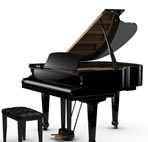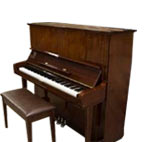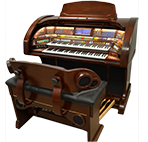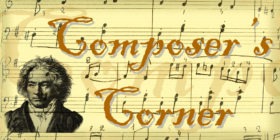
Johann Sebastian Bach - Public Domain Image from Wikimedia Commons
The Bach family is one of the most notable German musicians in history. Out of this lineage comes the celebrated composer Johann Sebastian Bach. But before him, there were other important members who proved to share the same appreciation for music. From the 16th to 19th century, there were more than 70 performers and musicians who made up this musically-gifted family. Here we will trace the genealogy of the Bach family.
When he was a young boy, Johann Sebastian sung in a choir at Michaelskirche, Lüneburg. He became organist in a church at Arnstadt in 1703. By 1707, he moved to Mühlhausen and married Maria Barbara Bach, his second cousin. There he composed several works, including “Cantata No. 71, Gott ist mein König” (1708), his first published work.
From Mühlhausen he moved to Weimar where he was court organist. When the music director at Weimar died, his son succeeded him instead of Bach. Because of this, Bach expressed desires to resign which the duke was vehemently against. Consequently, after being imprisoned by the duke for a month, Bach was released and he moved to Köthen.
At Köthen Bach became musical director and it is during his tenure there that he completed “The Brandenburg Concertos” (1721) and the first book of “The Well-Tempered Clavier” (1722).
On July 7, 1720, Bach’s wife, Maria Barbara, died. They had 7 children, 3 of whom died at an early age. Two known sons of Bach and Maria Barbara are Wilhelm Friedemann (1710 -1784) and Carl Philipp Emanuel (1714 – 1788).
A year later, on Dec. 3, 1721, Bach married Anna Magdalena Wilcken, a singer and daughter of a trumpeter. During his tenure at Köthen, Bach enjoyed a good relationship with the prince, that is, until he married. Once married, Bach’s relationship with the prince gradually changed and he again felt the need to move, this time to Leipzig by 1723. There he became director of church music and it was also during his stay there when he created many cantatas. In 1729 Bach produced the “St. Matthew Passion.”
Bach died on July 28, 1750 in Leipzig, leaving unfinished works such as “The Art of the Fugue” which was published in 1751. Bach and Anna Magdalena had 13 children, only a few of them survived to adulthood. Among them are: Gottfried Heinrich (1724 – 1763), Johann Christoph Friedrich (1732 – 1795), Lucia Elisabeth Munchhusen (1728 – 1803), Johann Christian (1735 – 1782), Elisabeth Juliane Friederica (1726-1781), Johanna Carolina (1737-1781) and Regina Susanna (1742-1809). Among his children, the three most notable composers are Wilhelm Friedemann (the eldest), Carl Philipp Emanuel (the second born) and Johann Christian (the youngest, also known as the “English Bach.”
From Great, Great Grandfather to the Great Composer
- Veit Bach – He was the great, great grandfather of Johann Sebastian Bach. Veit was born in Hungary, he was a miller who enjoyed playing the lute. He was forced to flee Hungary and move to Wechmar in Thuringia due to religious unrest. He died in 1619.
- Johannes Bach – He was the son of Veit and great grandfather of Johann Sebastian Bach. Johannes was given the opportunity to study music under the Gotha town-piper and he performed in nearby towns such as Eisenach, a city in the Thuringia Land of Germany. Johannes later on took over his father’s mill. Johannes had three sons – Johann, Heinrich and Christoph.
- Christoph Bach – He was the son of Johannes and grandfather of Johann Sebastian Bach. Christoph, along with his brothers, became professional musicians. He was an organist and was especially known as musician in the town of Eisenach.
- Johann Ambrosius Bach – The son of Christoph and father of Johann Sebastian Bach. He was a string player in Eisenach and was married to Elisabeth Lämmerhirt. They had 4 sons – Johann Christoph (1671 -1721), Johann Balthasar (1673 – 1691), Johann Jacob (1682 – 1722) and Johann Sebastian (1685 – 1750). Johann Ambrosius died in 1695. The eldest son, Johann Christoph, took the young Johann Sebastian under his wing after the death of their parents. Johann Christoph was an organist who studied under Johann Pachelbel, a known German composer of keyboard/organ music.
Did You Know?
- JS Bach wrote more than 1,000 compositions in every genre except opera.
- Bach used a musical cross with a note at the center as his signature. The musical cross was made up of 4 different pitches:
B: left staff using a treble clef
A: upper staff using a tenor clef
C: right staff using an alto clef
H: lower staff using a treble clef - Bach’s works are listed using the letters BWV followed by a number. BWV stands for Bach Werke Verzeichnis (Bach Works Catalogue); a catalog of Bach’s works arranged by genre.
- Bach and Handel both underwent cataract operations performed by an eye surgeon named John Taylor. Some say the operations may have hastened Bach’s death and Handel’s blindness.







